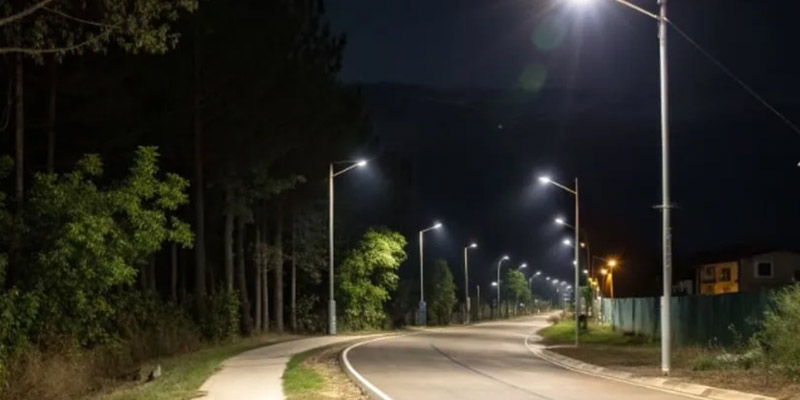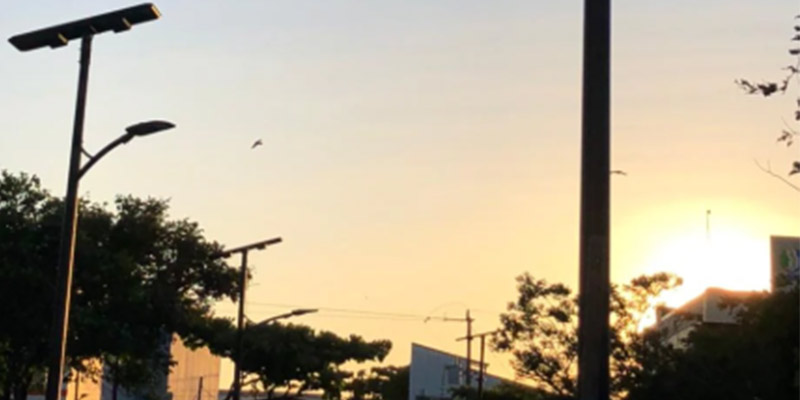When selecting solar street lights, 80% of buyers fixate on comparing “LED power” and “battery capacity,” treating the light pole as an “accessory.” Yet real-world cases reveal:
- A coastal project using standard steel poles saw them fracture from salt spray corrosion within three years, with rework costs doubling the original purchase price;
In a typhoon-prone area, poles with insufficient wind resistance toppled 12 units during a single storm, delaying the project schedule and incurring compensation for roadside vehicle repairs.
Light poles account for 70% of a streetlight's overall lifespan. Choosing the right one can extend service life from 5 to 10 years, while the wrong choice can render initial investments worthless.
Next, we'll break down 5 “practical light pole selection techniques” covering materials, height, wind resistance, and two real-world cautionary tales to help you avoid 90% of pitfalls.
Solar street light poles commonly use two materials: Q235/Q355 steel and 6063 aluminum alloy. Their suitable scenarios are worlds apart, and choosing the wrong one directly impacts lifespan.
| Material | Advantages | Disadvantages | Applicable Scenarios |
| Q235/Q355 steel | High load-bearing capacity (up to 500kg) and low cost (30% cheaper than aluminum alloy). |
It is prone to rust (requires anti-corrosion treatment) andis heavy (difficult to install in remote areas). |
Rural roads and inland municipal roads (without strong salt spray) |
| 6063 aluminum alloy | Corrosion resistant (salt spray test ≥2000 hours), lightweight (easy to transport and install). |
Weak load-bearing capacity (maximum 300kg), high cost |
Coastal areas, islands, and scenic spots (high humidity/salt spray) |
Avoid “Unmarked” Poles: Poles labeled only as “steel poles” without Q235/Q355 specifications are likely made from recycled steel and will crack within 3 years.
Coastal Areas Must Add “Electrophoretic Coating”: Standard spray-painted aluminum alloys fade within one year in salt spray environments. Electrophoretic coating extends corrosion resistance to over five years.
High Altitude Requires “Thickened Steel Poles”: Wind speeds exceed 3000 meters above sea level. Steel pole wall thickness must increase from 3mm to 4mm to prevent bending in strong winds.
Limited budget + inland scenarios: Q355 steel poles (wall thickness ≥3mm) + hot-dip galvanizing + powder coating (basic corrosion-resistant option);
High humidity + long-term use: 6063 aluminum alloy poles (wall thickness ≥2.5mm) + electrophoretic coating (upgraded corrosion resistance).

Many assume “taller poles mean wider illumination” or “closer spacing equals brighter lighting,” but this actually causes “uneven illumination” and “cost waste.”
Application Scenario Light Pole Height Pole Spacing Matching Solar Streetlight Power
Urban Main Roads 8-12 meters 30-50 meters 100-150W
Rural Roads 5-8 meters 20-30 meters 50-100W
Residential/Scenic Pathways 3-5 meters 15-20 meters 30-60W
Misconception 1: Installing 12-meter poles on rural roads — 12-meter poles on 8-meter-wide rural roads cause excessive glare nearby while creating dark zones farther away, wasting 30% of procurement costs.
Misconception 2: Installing at 15-meter intervals for 20-meter spacing — A section requiring 10 poles ends up with 13, wasting 25% of the budget while causing “light pollution” from overlapping illumination.
Lighting radius ≈ 0.7 × pole height (e.g., an 8-meter pole has a lighting radius of approximately 5.6 meters). Ensuring that the lighting radii of adjacent poles overlap by one-third avoids dark spots. For an 8-meter pole with 28-meter spacing (5.6m × 5 poles, overlapping 1/3 for full coverage), this achieves uniform illumination while saving costs.
In typhoon or high-wind zones, improper wind resistance ratings can render projects useless after a single storm. .
Typhoon-prone zones (Southeast Asia, China's coast): Wind resistance ≥ Level 12 (maximum wind speed 32.7 m/s);
Inland regions (Central Africa, U.S. Midwest): Wind resistance ≥ Level 8 (maximum wind speed 20.7 m/s);
High-altitude regions (Nepal, Tibet, China): Wind resistance ≥ Grade 10 (frequent strong winds year-round, often reaching 24.5 m/s).
Flange dimensions: For an 8-meter light pole, the base flange (metal plate connecting to the ground) must be at least 300×300mm with a thickness ≥10mm. A flange that is too small will cause the pole to tilt. In one project using a 200×200mm flange, 9 out of 15 poles fell after a typhoon.
Bottom Reinforcement Ribs: Adding 2-3 reinforcement ribs (metal strips) at the bottom 1.5 meters of the pole can increase wind resistance by 40%. This is mandatory in high-altitude and typhoon-prone areas.
Don't trust “verbal assurances”: Manufacturers must provide a “wind tunnel test report” clearly stating test wind speeds and results. Claims like “withstands Category 12 winds” without supporting reports are likely false.
Add “deflector plates” at high altitudes: Above 3,000 meters, turbulent winds require installing “deflector plates” (metal plates reducing wind resistance) at the pole top to prevent strong winds from impacting the lamp head and bending the pole.
Many projects discover on-site that purchased poles are incompatible with luminaires or foundations, causing unnecessary delays.
- Top diameter must match luminaire: 50-100W luminaires require 60mm diameter poles. If mistakenly purchased as 50mm diameter, and no cutting tools are available on-site, new poles must be ordered. One African project incurred a one-week delay and $5,000 in downtime compensation due to this issue.
Select mounting method based on weight: Steel poles over 8 meters (weight ≥100kg) require “embedded installation” (1.2×1.2×1.2m concrete foundation). Aluminum poles under 5 meters (weight ≤50kg) require “flange mounting” (bolt-fixed). Incorrect installation causes instability.
Reserve maintenance access door: Install a 15×20cm lockable access door 1 meter from the base. This allows controller/battery replacement without dismantling the pole. A residential complex omitted this door, requiring pole sawing during battery replacement—both cumbersome and detrimental to pole lifespan.
A Southeast Asian resort project procured aluminum poles with a 50mm top diameter but paired them with 80W luminaires (requiring 60mm diameter). Without on-site cutting equipment, new poles had to be shipped from China, delaying installation by 10 days. This missed the resort's opening date, resulting in a $20,000 penalty.
When light poles fail (rusting, breaking), manufacturers will shift blame if certifications are absent or warranties are ambiguous, leaving the purchaser to bear the losses.
Domestic Projects: Must comply with GB/T 24609-2021 “LED Light Poles for Road Lighting.” Without this certification, municipal project acceptance will fail outright.
Overseas Projects: CE certification for Europe, UL certification for the U.S., SONCAP certification for Nigeria. Uncertified poles risk customs detention—one project saw 100 poles held for 2 months in Nigerian customs due to missing SONCAP certification.
Substandard manufacturers' tactics: “1-year warranty” covers only “non-human damage,” but rust and corrosion are dismissed as “environmental issues” and not repaired.
Premium manufacturers' commitments: Steel poles warrantied ≥5 years (covers rust and breakage), aluminum alloy poles ≥10 years (covers corrosion and deformation), with free replacement parts and labor during warranty periods.
Insist on a “written warranty letter”: Clearly states “what is covered, duration, and claims process”; never rely on verbal promises.
For overseas projects, verify “local after-sales service”: Confirm if the manufacturer has partnered service centers in the target country (e.g., Kenya, South Africa). Without local support, repairing a single pole may take 1-2 months, disrupting project operations.

Cutting corners by buying cheap poles — $50 standard steel poles rust within 2 years, while $80 hot-dip galvanized steel poles last 8 years. High-quality poles save money long-term.
Ignoring local climate — Using standard steel poles in coastal areas results in 30% rusting within 1 year. Spend 20% more on aluminum alloy poles instead.
Skipping sample testing — Before bulk orders, purchase 1-2 samples to test load-bearing capacity (hanging 1.2x lamp weight) and corrosion resistance (72-hour saltwater immersion). Only proceed with bulk orders if passed. One project skipped testing and received thin-walled poles, requiring rework.
Selecting solar streetlight poles hinges on the “3 Matches”:
Material matches environment (aluminum for coastal areas, steel for inland regions);
Height and spacing match power output (calculated by illumination radius);
Wind resistance rating matches location (Typhoon Category 12 for coastal areas, Category 10 for high altitudes).
If you're selecting poles, contact us directly for a “customized solution.” We handle everything from sample testing and on-site installation guidance to 5-10 year warranties—eliminating rework and delays.